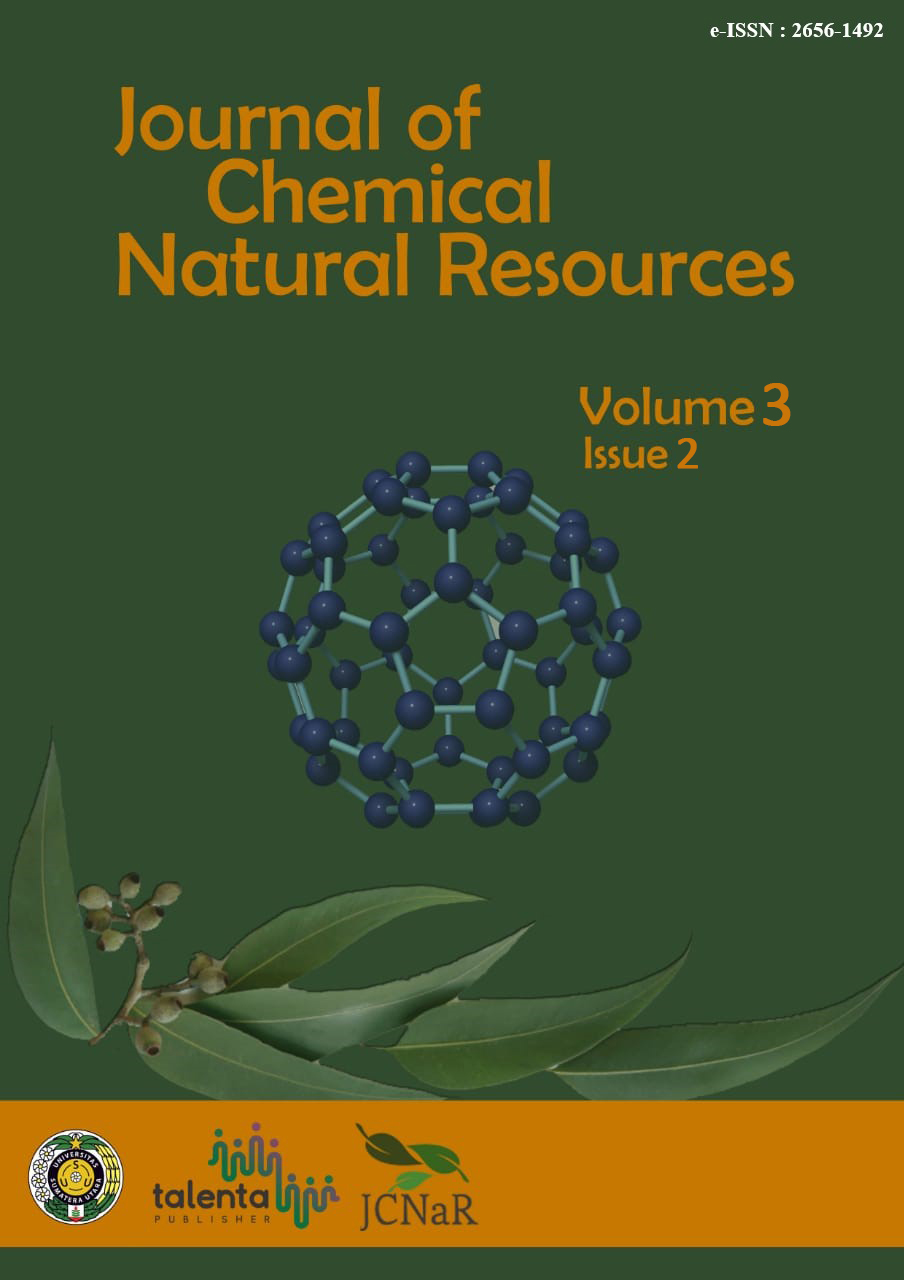Fabrication and Characterization of Glucosamine Hydrochloride from Chitin of Horseshoe Crab Shell (Tachypleus gigas)
DOI:
https://doi.org/10.32734/jcnar.v3i2.9350Keywords:
Glucosamine Hydrochloride, Chitin Shells of Horseshoe Crab, Analysis FT-IRAbstract
Preparation of glucosamine hydrochloride from the chitin of horseshoe crab shells using the chemical hydrolysis method has been done using HCl concentration variation ratios of 7%, 9%, 11%,14 % with a ratio of 9:1 (v/w) for 4 hours at a temperature of 90ºC. Determination of glucosamine hydrochloride characteristics was characterized using Fourier transform-infra red (FT-IR) spectroscopy, in which the characteristics of glucosamine hydrochloride obtained in the OH group of glucosamine hydrochloride were 3446 cm-1 (s), 3448 cm-1 (s), 3450 cm-1 (s), 3448 cm-1 (s), respectively. For NH group of glucosamine hydrochloride were 1557 cm-1 (s), 1559 cm-1 (s), 1556 cm-1 (s), 1560 cm-1 (s), respectively. For CN group of glucosamine hydrochloride were 1379 cm-1 (m), 1379 cm-1 (m), 1379 cm-1 (m), 1379 cm-1 (m), respectively. While the glycoside bond of glucosamine hydrochloride 1073 cm-1 (w), 1074 cm-1 (w), 1074 cm-1 (w), 1074 cm-1 (w), respectively. Determination of the concentration of glucosamine hydrochloride with Ultraviolet Spectrophotometer analysis at a maximum wavelength of 197 nm with a standard solution of N-acetyl glucosamine in a solution of phosphate acid 0.005%, in which obtained the concentration of glucosamine hydrochloride 7% = 33.67 ppm, 9% = 36.35 ppm, 11% = 40.16 ppm, 14% = 43.97 ppm.
Downloads
References
Agusnar, H. 2006. Potential of Shellfish (Tachypleus gigas ) in North Sumatra Waters as Chitin and Chitosan Material. Chemical Science. Volume 8. PP 22-2.
Bastaman S. 1989. Studies on Degradation and Extraction of chitin and Chitosan From Prawn Shell (Nephrops norvegicus) [Thesis]. Belfast: Faculty of Engineering, The Quen's University of Belfast.
Dr. Craig WM 2004. Glucosamine: Review of its Effectiveness in Treating Knee Osteoarthritis
Fessenden , RJ & Fessenden, JS 1983. Organic Chemistry. Second Edition. Volume 1. Jakarta: Erlangga
Hirano S. 1986. Chitin and Chitosan. In Ullmann's Encyclopedia of Industrial Chemistry.Completely revised edition.Weinheim, New York.
Knorr D. 1991. Recovery and Utilization of Chitin and Chitosan in Food processing Waste Management.Food Tech.45 (1):114-122
Kralovec JA, Barrow CJ. 2008. Marine Nutraceutical and Functional Foods: Glucosamine Production and Health Benefits. Canada: CRC Press.
Mojarrad JS, Mahboob N, Valizadeh H, Ansarin M, Bourbour S. 2006. Preparation of Glucosamine from Exoskeleton of Shrimp and Predicting production Yield by Response Surface Methodology. Journal of Agricultural and Chemistry 55:2264-2250
Muzzarelli, RAA 1978. Chitin. Oxford : Pergamon Press
Purwantiningsih S, Wukirsari T, Sjahriza A, Wahyono D. 2009. Chitosan: Future Source of Biomaterials. First Print. Bogor: IPB Press
Rotta Research Laboratory. 1987. Stable Compounds Of Glucosamine Sulphate. US Patents 4,642,340.
Silverstein, Robert M. 1986. Spectrometric Investigation of Organic Compounds. Jakarta: Erlangga
Underwood, AL 1983. Quantitative Chemical Analysis. 4th Edition Jakarta: Erlangga Publisher
Downloads
Published
Issue
Section
License
Copyright (c) 2022 Journal of Chemical Natural Resources

This work is licensed under a Creative Commons Attribution-ShareAlike 4.0 International License.















